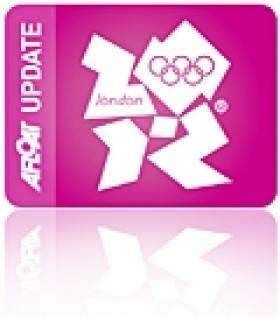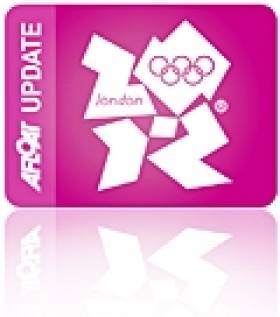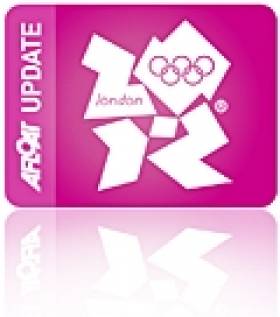Displaying items by tag: Skandia Sail for Gold Regatta
BBC To Air Skandia Sail for Gold Regatta
The BBC is set to broadcast two documentaries on Olympic Classes sailing, produced by Sunset+Vine|APP in association with BBC Sport. Part 1 of “Olympic Sailing” will air this Saturday, 21 August , at 1300 on BBC 1. It tells the story of Britain’s medal winners at the Skandia Sail for Gold Regatta where nearly 1000 sailors from 57 nations competed at the Weymouth and Portland National Sailing Academy, the venue for the sailing competition for the London 2012 Games.
The documentary will follow the highs and lows of this international competition that includes Britain’sBeijing gold medalliists Ben Ainslie, Iain Percy and Sarah Ayton plus a host of medallists from the 2008 Games, as they compete on home waters exactly two years ahead of the London 2012 sailing competition.
BBC cameras were invited behind the scenes into the Skandia Team GBR camp for an exclusive tour of the new team accommodation just metres away from the Olympic venue where Shirley Robertson – herself a double Olympic gold medallist - discovers the systems the British team have put in place in order to have the best chance of winning medals. She meets Skandia Team GBR’s newest support crew member, falconer Brian Williams, who with his birds of prey at six o’clock in the morning take on the dawn chorus of local seagulls in a bid to provide the sailors with their last hours of valuable sleep.
The documentary catches up with medal-winning husband and wife team Nick Dempsey and Sarah Ayton, and joins Ainslie, Percy and his crew Andrew ‘Bart’ Simpson for an insight into what makes this renowned team tick. Shirley also meets the young British team sailors struggling to get into the elite squad and earn themselves a place in the main squad where no stone is left unturned in the quest for medals.
The Skandia Sail for Gold regatta was the largest ISAF Sailing World Cup event in 2010, and provided an insight for many 2012 teams into the future Olympic venue.
On Sunday 5 September at 1400 on BBC 2, “OLYMPIC SAILING” (Part 2) will come from Hayling Island on the final day of the Laser World Championships where Beijing gold medallist Paul Goodison is out to defend his title. The programme will also include features on the man to break Ben Ainslie’s six-year winning record in the Olympic Finn class, 23 year-old British sailor Giles Scott, and on perhaps the happiest medal winner of all at the last Games – Britain’s Britain's Bryony Shaw who windsurfed to bronze in China.
BROADCAST TIMES:
“OLYMPIC SAILING” (Part 1) Saturday 21 August 1300 – 1350, BBC1
“OLYMPIC SAILING” (Part 2) Sunday 5 September – 1400, BBC2
BOTH PROGRAMMES CAN BE WATCHED ON BBC iPLAYER after transmission dates
Big Breeze Brings Big Results in Weymouth
Peter O'Leary and newly adopted German crew Frithjof Kleen were winners in the single Star keelboat race today but only after an international jury granted redress to the Cork helmsman who crossed the line second at the Skandia Sail for Gold regatta in Weymouth this afternoon. A second win for Ireland was secured in the big breeze by Annalise Murphy in the Laser Radial class who also scored second in this morning's race, rounding off a successful day for the 11 strong Irish crew off the Portland Bill. Below is a podcast update from Team Manager James O'Callaghan as the crews came off the water this evening.
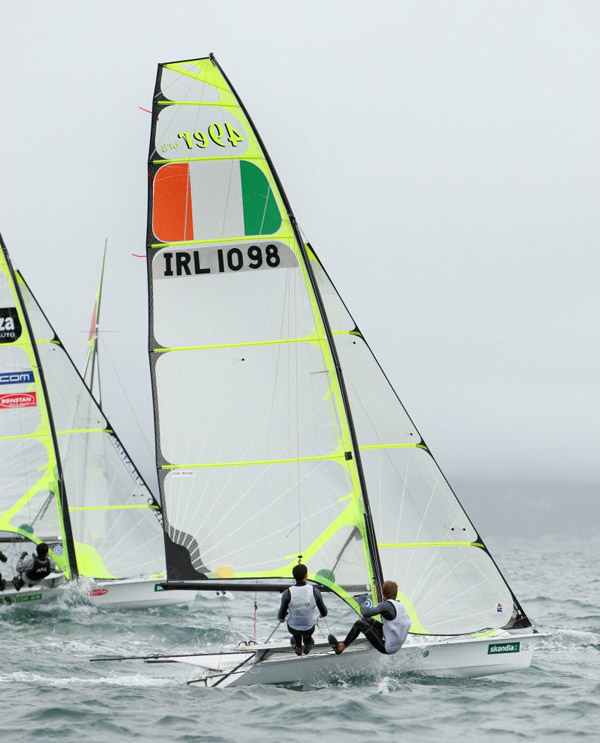
(Above) Ed Butler and Ben Lynch (IRL) in action in the 49er class on day 2 of the Skandia Sail for Gold Regatta and (below) Saskia Tidey in the Laser Radial . Photo OnEdition
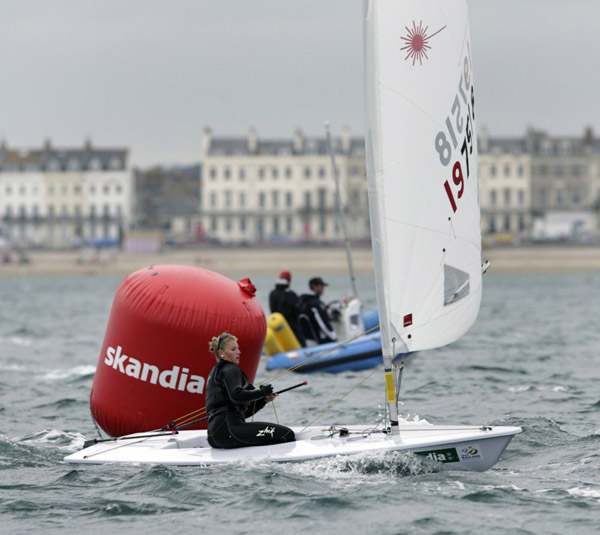
Irish Olympic Stars in Action in Weymouth
The clearest indication of Irish sailing form for the 2012 Olympics will be known this week when four Sports council carded sailors go into action in a massive regatta of 800 sailors at the Skandia Sail for Gold Regatta in Weymouth. Annalise Murphy is in the Laser Radial and in the Star class Max Treacy and Anthony Shanks go head to head with Peter O'Leary who the Irish Times says this morning has had a last mniute crew change. David Burrows is out and Germany's Frithjof Kleen is sailing as a late substitution.
If you took a wander around the fine old English seaside resort of Weymouth, you'd find a mix of motives for being there on this particular Sunday in August – the beach, the sea, the ice cream. Move round the bay a little to the Weymouth and Portland National Sailing Academy, where the elite of Olympic sailing are gathered for Skandia Sail for Gold 2010, and you'd think that the replies would be a little more focused – winning, perhaps? But you'd be wrong...
It might be the final event of this year's ISAF Sailing World Cup, not to mention the last but one Olympic class regatta at the 2012 venue before the main event, but not everyone is necessarily here to win. The Dutch 470 sailors, Lisa Westerhof and Lobke Berkhort have racked up five 470 World Championship titles between them, including the most recent, along with Olympic silver in Beijing for Lobke. But when Lisa was asked if they had a choice between going left on the race course to stay with their competition, and going right to learn more about the venue, she replied, "We might choose the right, but we'll have to see," adding with a laugh, "It's nice to have a good result, we're sportsmen, we like to win."
Lisa and Lobke are out of contention for the ISAF Sailing World Cup, but Emmanuelle Rol and Hélène Defrance are just one point behind their French compatriots overall, Ingrid Petitjean and Nadège Douroux. But Rol reckons they have a weakness in breezier conditions after a poor performance at the World Championships, and is hoping to establish that they have improved after training in the Mistral in Marseille, "For us, the result is important, but also to try to have good races in strong conditions, and of course, learn about the Olympic venue. And so far, we have learned that the weather is not as good as in Marseille." The last said, we're sure, purely in jest...
US Sailing Team AlphaGraphics meteorologist (and former holder of the same position for the Luna Rossa America's Cup team), Doug Charko reckoned that Rol and Defrance will have plenty of opportunity to check their heavy weather progress, "There's a low heading into the area, which will probably arrive for Tuesday. So ten to 15 knots for Monday, building during the day, and then Tuesday with the low passing over Scotland there's quite a wide range in the global models, so although I'm hedging my bets a little, I'd say 15 to 20 and gusting to 25 knots from the south-west, raining and unsettled." Things look a little better for the rest of the week, with moderate south-westerly sea breezes forecast – classic Weymouth conditions.
Another Women's 470 contender who theoretically doesn't need to learn much about the venue is double Olympic Yngling Gold medallist and Weymouth resident Sarah Ayton. After recently returning to sailing following the birth of her first child, Ayton and her crew Saskia Clark is not in contention for the overall ISAF Sailing World Cup. But Sarah nevertheless finds herself with a similar balancing act; "You've got to use the opportunity to learn, you don't get many opportunities with a world class fleet in this venue, so it is important to learn. But obviously, it is important to perform in the Olympic venue, so it is a real balancing act of trying things when you can, but bearing in mind the end results." When asked the left or right-side of the course question, she replied with a smile, "It would be hard not to stay with the competition."
Sarah was up on the stage for a very bling opening ceremony, the new Olympic venue dripping with medals two years early. Many of those present are sailing in the Star class, which has some serious star-wattage. Double Olympic-medallist and current Star World Champions, Iain Percy and Andrew Simpson had come straight from Team origin's win over current America's Cup holders, BMW Oracle, in the 1851 Cup.
For Iain Percy, it was a chance to learn about the venue, reckoning that they had to look at each Olympic venue afresh, in a much more analytical, professional way. But there were other reasons for coming to Weymouth, "Myself and Andrew do a lot of other sailing, and whenever we get back in the Star we always have a really good time, relax and enjoy it, old mates going out for a sail. So whenever we get a bit of a window in the calendar we jump at trying to get out in the Star for a bit of fun, and that's the main reason we're here."
Further Quotes
Lisa Westerhof (Holland, Women's 470, current World Champions), on their priorities for Skandia Sail for Gold; "We do set priorities during the year and our main goal this year was the World Championships. We use the World Cup to work with our processes and to develop equipment. We'll use this week to get to know the conditions in Weymouth and to get a feel for the water and the sailing conditions. But the weather and the systems - the low pressure and high pressure weather systems - the variety in the weather is comparable to Holland, so we feel at home."
Emmanuelle Rol (France, Women's 470, currently second in ISAF Sailing World Cup), on their priorities for Skandia Sail for Gold; "We are using the same equipment here as at the Worlds - developing gear will be the winter's task, we will try some new stuff then. We are quite a new crew together, so we had to work out our team work, and our next job will be to work on the equipment."
Iain Percy (Britain, Star, current World Champion), on the topic of keeping current with Olympic sailing, while balancing it with other sailing commitments; "I tried a little experiment after 2000 with the Finn, when I used to go back and have a race against the guys - and after nine months I felt pretty good, but then when I went back and tried it a couple of years later I was absolutely hopeless. So somewhere between your brain and your hands there's a memory that runs out after a certain amount of time."


























